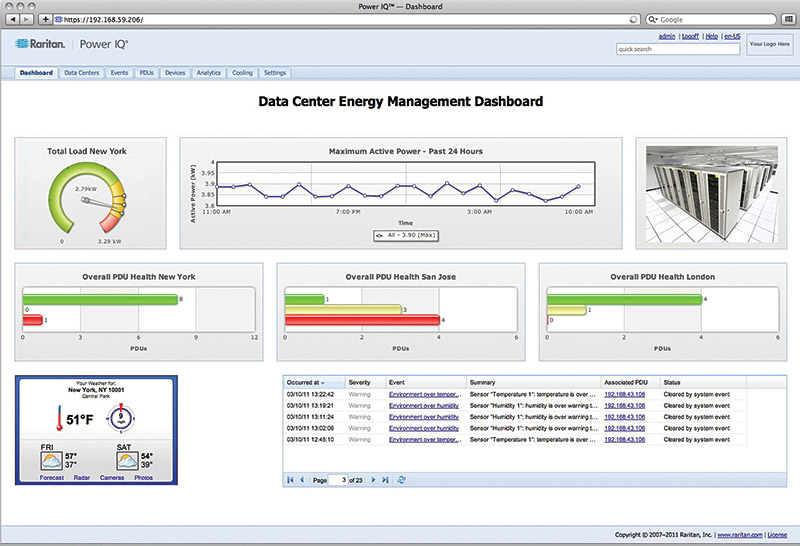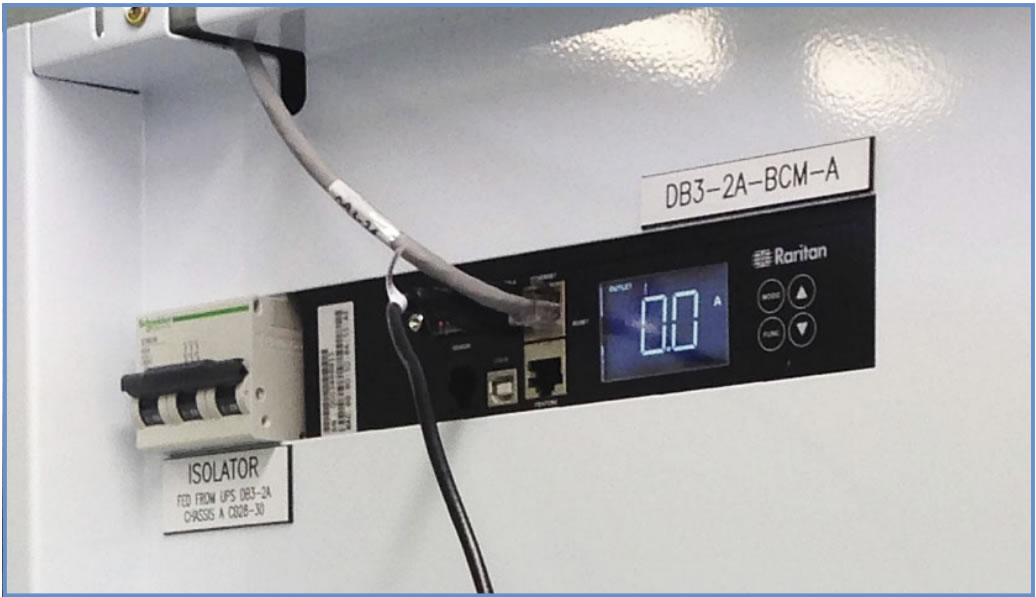
Home » Resources » Case Studies » Commander
How One of Australia’s Leading Telecom Providers Keeps Tab on Data Centre Energy Usage and Power Capacity
From its new data centre energy dashboard, the colocation provider tracks energy bills, PUE, and the energy consumption of its tenants.
As one of Australia’s largest telecommunications carriers, Commander, is known for its breadth of offerings — ranging from telephony and mobility solutions to high-speed broadband and hosting services — and for its use of leading technologies to provide these services. Its colocation business is no exception; it has “invested extensively to incorporate some of best technology available to create one of the most secure and reliable data centre facilities in Australia.”
Thousands of businesses and organizations — including financial institutions, retailers, law firms and energy companies — rely on Commander data centre services. Although most customers look after their own IT equipment infrastructure residing in the dedicated space provided in the telecom provider’s data centre, Commander has an onsite team of systems engineers and network engineers available 24/7 to support customers. The data centre team also uses a number of building system and IT infrastructure monitoring tools to keep an eye on the health of its high-performing data centre.
But none of the existing tools could provide accurate real-time information and insight on energy usage, especially at the customer level.
For most data centres the monthly power bill is the most significant operational cost
A large bill arrives each month without details or breakdown on usage. Tantamount to a family home’s utility bill — you know how much electricity the entire household uses and the price for that electricity, but there is no way of knowing how much each household member, or room, in the house consumes. Without access to information on actual customer power usage, colocation providers have historically had to charge customers a fixed price for power.
Another related concern for Commander was the lack of real-time visibility into the data centre’s overall power capacity — the total available power for a data centre, whether it’s the amount of power available from the utility company or a generator’s capacity. This is critical information needed to help with decisions on where to add customer equipment in the data centre in order to avoid circuit overloads.
A Smart Energy Marketing Solution
Bruce Klimeck, National Data Centre Operations Manager at Commander, had started to search for a better way to measure and track how energy is being used in the Commander data centre. “The best route to gain insight on power consumption is to monitor the power at the source closest to the customer level; at the circuit level, in our case,” says Klimeck.
At the time Commander was searching for an energy monitoring solution, a new environmental performance rating system for data centres was emerging in Australia. The new national rating system, NABERS (National Australian Built Environment Rating System), will require data centres to be rated for energy efficiency.
“When we learned about Raritan’s intelligent power solutions that monitor energy at the circuit and rack PDU level, we thought that Raritan’s solution would fit the bill,” says Klimeck. “With NABERS coming down the pipeline, the timing was good for us to start implementing an energy management solution.”
Branch Circuit Monitoring Key to Utility Bill Insights
Although Commander had meters in its existing electrical sub panels, it wanted to be able to measure and collect data on individual circuit use in real-time; and, eventually, be able to give customers access to the electricity usage data as well.
“We wanted an energy monitoring solution that could be installed without disrupting our operations or require the expense of replacing equipment,” says Klimeck.
To track actual energy usage of each power circuit, Commander uses Raritan’s Branch Circuit Monitor (BCM) solution. The centralized management solution measures and monitors the power and energy consumption of each conductor in electrical power panels located throughout the data centre.
Important metrics — real-time current (amps), voltage, apparent power (VA), active power (W) and energy consumption in Wh — can be easily seen from a remote user interface on the web or on the BCM’s LCD display. Ideal for metered billing applications, the BCM unit measures Wh in real-time to ISO/SEC +/-1% billing-grade accuracy.
Smooth Implementation
To monitor 450 individual circuits, Commander installed 32 Raritan BCM units across seven switchboards. By collecting power and energy data on branch circuits, the BCM units deliver an accurate view of energy use and power capacity.

Before purchasing the Raritan solution, Commander conducted a trial with an existing customer, who had a sub-board at their colo rack. After using the BCM units to monitor two circuits on each stream for six months, the Commander team was satisfied with the accuracy and usefulness of the information generated by the Raritan solution.
Implementation of the solution for the entire data centre took two weeks. During deployment, there was no service disruption because the BCM solution enables current transformers to be snapped around existing circuits without requiring power to be cut to the equipment racks. For a more streamlined installation, Lanec Services Pty Ltd. — the electrical contractor responsible for the BCM solution installation at Commander — built customized switchboards to house the Raritan BCM units. The custom switchboards have extra capacity to support the expansion and new equipment, such as security webcams for capturing when a panel door is opened.
Measuring Actual Customer Usage with Power IQ Software
The power information gathered by the BCM system is analyzed by Raritan’s Power IQ® energy management software, which shows on a web-based dashboard how the data centre is consuming energy. Information is presented in user-configurable charts, graphics and reports that can be accessed from anywhere on the Power IQ dashboard. Reports can be easily tailored to look at power over any user-defined time periods and at any point in the path from where power enters the building to the rack. Power IQ also can be used to set up alerts if certain power thresholds are crossed.
- “We wanted an energy monitoring solution that could be installed without disrupting our operations or require the expense of replacing equipment.”
- Bruce Klimeck
Commander National Data Centre Operations Manager
To populate Power IQ’s database with details on each customer circuit, Commander created an import spreadsheet with information that defines each circuit — including panel board, the circuit breaker, breaker size, IP address, the cabinet reference number, and customer name assigned to the circuit. As a result, Commander is able to use Power IQ to look at energy usage trends of the data centre, down to the customer level. The BCM’s utility-grade accuracy enables Commander to be confident in the accuracy of the amount it bills customers for energy usage.
“At the end of each month, Power IQ generates energy usage reports that we use to charge customers for power consumption,” says Klimeck. “It provides us with valuable information to help us support our customers, accurately monitor power consumption, and help make our data centre more efficient.”
Measuring PUE and Reducing Carbon Footprint
Commander keeps an eye on its data centre’s Power Usage Effectiveness (PUE) ratio, an important energy-efficiency metric used by the industry. PUE is calculated by dividing the amount of power entering a data centre by the power used to run the actual IT equipment of a data centre.
Armed with information on the IT load provided by Power IQ and the power information from the main breaker, Commander can easily track its PUE. “The PUE, plus the trending information that Power IQ provides, will come in handy when we need to provide information for the NABERS data centre energy rating program,” says Klimeck.
“Data Centres in Australia soon will need to be able to accurately monitor power, so they can determine data centre STAR ratings required by NABERS,” adds Klimeck. “The only way this can be accomplished is to monitor at the source, which can be done by retrofitting with a BCM system.”
In the future, Commander may choose to provide their customers with login access to the Power IQ portal so that they can track their own energy usage. With Power IQ’s simple-to-configure dashboard, Commander will be able to create custom portal views for its customers. The expectation is that access to the information will help with energy conservation efforts. Data centre tenants, for example, will be able to track if energy-conservation efforts — such as turning IT equipment off when not used or the installation of more energy-efficient equipment — are working.
Armed with accurate energy monitoring information, Commander’s data centre and its tenants are on their way to a greener data centre.
Learn More About Raritan

Customer
Commander
Challenges
- Access real-time accurate power information per rack to help in planning for growth and to avert down time.
- Monitor customer power usage per rack; and, have the ability to let customers see in real-time their individual energy usage levels.
- Easily document and track data centre energy efficiency for government data centre rating organization.
Solutions
- Branch Circuit Monitoring (BCM) units
- Power IQ® energy management software for reporting and billing
Results
- Power monitoring from anywhere with billing grade (+/- 1%) accuracy.
- Visibility into energy usage by customers in multi-tenant environment.
- Low-cost, non-obtrusive implementation.
- Energy dashboard that delivers easy-to-understand charts, images and graphics for insights on energy costs, rack capacity and potential health issues in the data centre.

